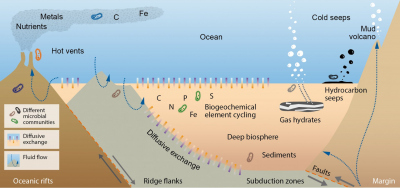- Cluster Ocean Floor
- Research Unit REACTOR
- Research Themes
Research Themes REACTOR
The dynamic ocean floor is a biogeochemical reactor that influences the global-scale distribution of elements that are vital for life, modulates global climate on geological timescales, and fuels rich biological communities at and below the seabed. The impacts of this reactor on the global carbon cycle, on global climate, on long-term evolution of ocean chemistry, and on the diversity of life are poorly constrained, let alone properly quantified.
Focusing on three Themes, the Research Unit REACTOR will examine reactions in the oceanic crust and at the ocean floor, quantify their regional- to global-scale impacts, explore and quantify biotic and abiotic processes and their mechanisms, and examine the associated geosphere-biosphere interactions and key components of the related ecosystems. Many factors control the direction and magnitude of exchange between the reactive ocean floor and the ocean, including the composition of subsurface rocks, sediments and hydrocarbon reservoirs in different geotectonic settings.
Main objectives / expected achievements in the REACTOR:
- To examine the relationships between plate tectonics and the chemical composition of the ocean we will quantify and budget chemical fluxes in a variety of marine geological settings.
- To determine habitability within the ocean floor and quantify the role of the deep biosphere
in element cycles we will reveal the chemical and physical factors that define the lower
boundary of the biosphere below the ocean floor and identify its impact on element cycles. - To disclose the impact of gas seeps and hot vents on life at the ocean floor and in the deep
ocean we will determine the relationships between geological processes, the chemical
compositions of emitted fluids, and the resulting biological activity and diversity.
An organizational overview of the program is provided in the following table.
| REACTOR | Theme 1 | Theme 2 | Theme 3 |
| Title | Seawater-crust interactions | Deep biosphere and element cycling in sediments | Processes and dynamics of vents and seeps |
| Research focus, spatial | Below ocean floor, primarily non-sedimented | Below ocean floor, primarily sedimented | At and above ocean floor, primarily sedimented |
| Contributions to overarching objectives (Obj.) of the Cluster | Element fluxes and budgets (Obj. 2); ecosystems and biogeochemical cycles (Obj. 3) | Element fluxes and budgets (Obj. 2); ecosystems and biogeochemical cycles (Obj. 3); warm-world scenarios (Obj. 4) | |
| Most important links within the Cluster (T = Theme) |
Climate-ecosystembiogeochemistry feedbacks (RECORDER T2); impact on ocean chemistry and climate (Enabler MODELING) | Transformation of biogenic particles (RECEIVER T1); detection of life and its activity (molecular isotopic approaches; Enabler TRACERS) | Recording the reactor (RECORDER T1 and Enabler TECHNOLOGY) |
| Key study sites | Eastern Equatorial Pacific ridge flanks, North Atlantic rifted margins and spreading ridges | Nankai Trough, Guaymas Basin, Helgoland mudflat, Argentine Basin | Submarine volcanic arcs, Cascadia margin, Guaymas Basin, mid-Atlantic ridge |
| Joint study sites | — North Atlantic, Mediterranean Sea — | ||
| Disciplines | Geophysics, geodynamics, geochemistry, biogeochemistry, geobiology | Biogeochemistry, microbial ecology, organic eochemistry, geobiology | Biogeochemistry, microbial ecology and physiology, marine geology, chemical oceanography |



